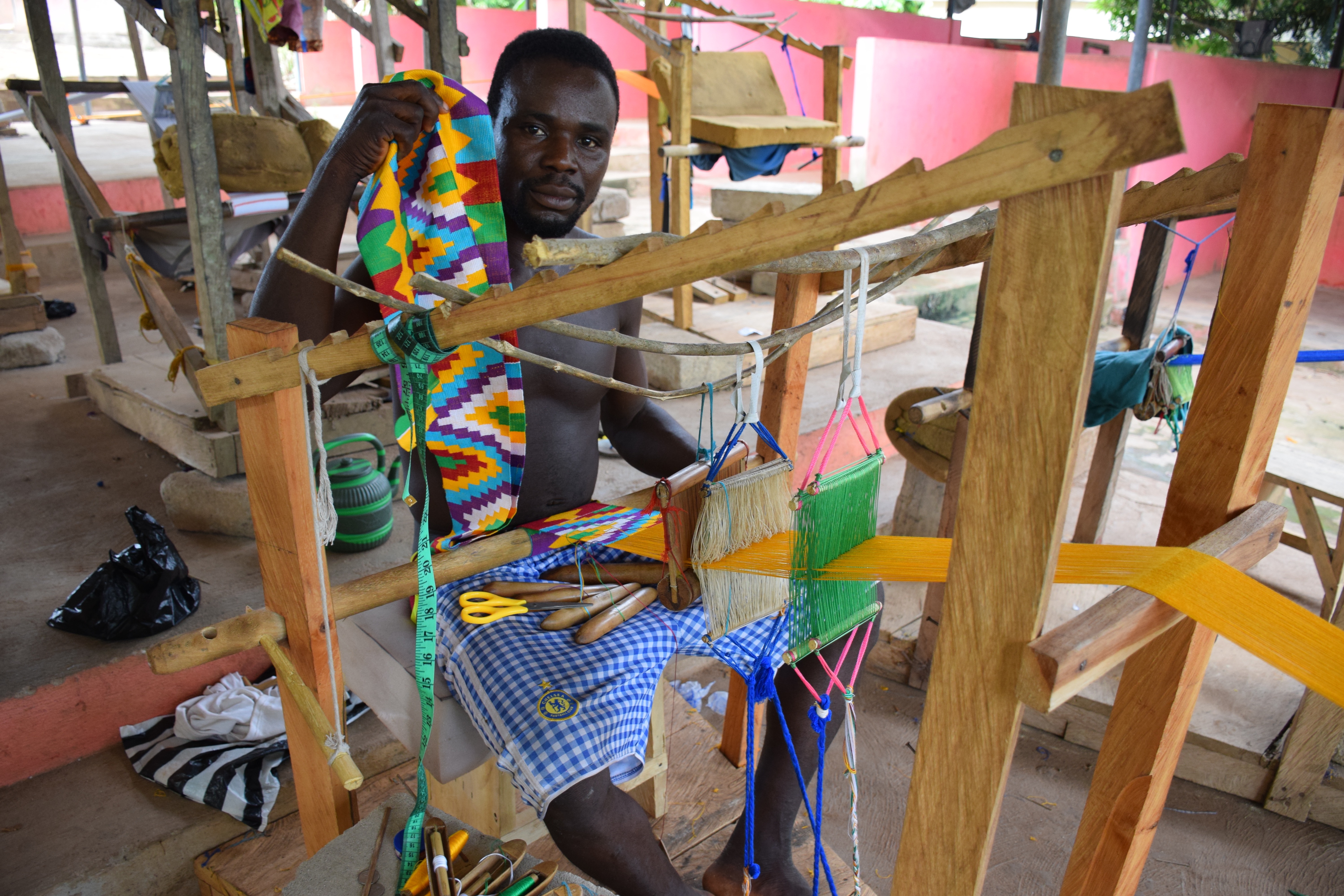
Looking Into the Past at the Adanwomase Weaving Village
By Olivia Burton
[divider]
[dropcap]W[/dropcap]e arrived in the Adanwomase weaving center late on a Sunday afternoon. During the half-hour drive from Kumasi, we passed several large crowds of people dressed in black and white fabric in a variety of patterns, all gathered under or near a rectangle of white pop-up tents. The people were often arranged around a large photograph of a recently deceased neighbor or family member, usually shown wrapped in colorful kente cloth, a traditional woven cloth in a variety of patterns that has been made in the region for centuries. Each pattern, which the weavers know by memory, represents a historical event, a virtue, an aspiration, or an identity. The family of the deceased, we later learned at the weaving center, often wears the same or similar kente cloth so that mourners can recognize them.
With this ceremony of thanksgiving for the life of the deceased happening as it does nearly every Sunday in the Ashanti region, most of the wooden looms at the weaving center were empty. Still, since the center is a popular tourist destination as well as a fully functional production center for authentic kente cloth, tour guide Ammim G. Cosmos—just “Cosmos” as he introduced himself—met us at the door to the visitor’s center.
Relative to the many centuries through which the Akan people have produced kente cloth, the Adanwomase weaving center is brand new. In 2007, the European Commission chose to support the “Ghana Traditional Textile Project: Conservation and Tourism Development.” The Commission hoped that by opening a visitor-friendly kente weaving center, they might stimulate the local economy through tourism and trade while preserving cultural heritage. The center, which officially opened in 2009, supports traditional textile weavers from the Ashanti, Volta, and Northern regions of Ghana.
We sat down in a row of green and white plastic chairs beneath framed samples of various patterns of colorful kente cloth. As Cosmos began to explain the history of the production of the cloth, he passed around samples of cotton, rayon, silk, and metallic fiber, the four materials used to produce kente cloth today. Holding up a clump of raw cotton, he plucked at a tuft and twirled it into a short string. Originally, he explained, all of the threads for kente cloth were painstakingly rolled by hand. Because it was so difficult to make, it was reserved only for royalty. Today, however, anyone who can afford it can wear it.
“Kente is a visual representation of history,” he explained, standing up and gesturing to the samples of cloth lining the wall around the ceiling. “It’s a powerful cultural symbol and a source of pride.”
Every design, Cosmos said, has a name and a meaning. One might mean, “behind every man is a successful woman.” Another commemorates President Kwame Nkrumah’s liberation and unification of Ghana in 1957. A man might use a different pattern to tell a woman that he loves her. Other patterns convey different messages: strong man, strong woman, happy family, education, love, and unity are a few he listed. Graduating students often wear the education pattern as a stole.
Cosmos led us out of the visitor’s center to one of the weaving facilities, a large open-air pavilion with looms facing a lush green forest. Three men were still working at the looms. One man, hunched over his loom in blue checkered shorts, juggled five spools of colored thread in green, white, turquoise, purple, and red. As he weaved the colors into the mustard yellow base, the five spools and the shuttle he used to work them into the threads appeared to be extensions of his fingers. In spite of his incredible speed, however, a single foot of the cloth could take hours to make.
All of the weavers work by memory. If they make a mistake, they must work backwards to undo it before continuing. It’s a skill that requires months of practice and constant attention. The human effort and skill required to produce kente cloth adds greater meaning to this cloth that plays such an important role in weddings, funerals, graduations, coronations, historical events, and celebrations. More than just a beautiful work of art, Cosmos explained, kente cloth is an unwritten story, passed down through the centuries.
[hr]
Olivia Burton ’18 is an English major in Morse College. Contact her at olivia.burton@yale.edu.